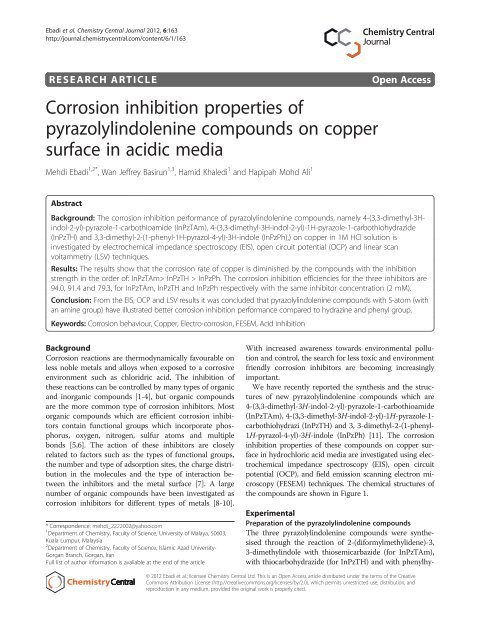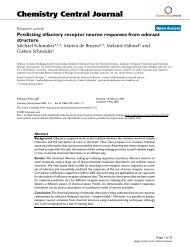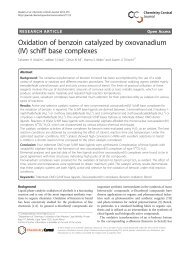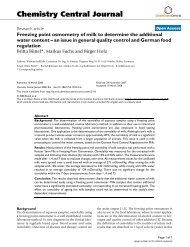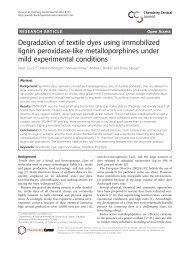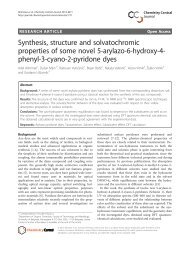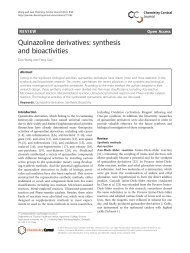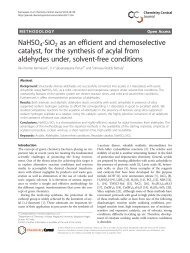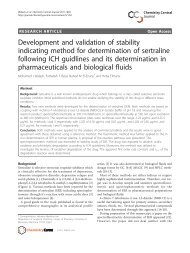PDF - Chemistry Central Journal
PDF - Chemistry Central Journal
PDF - Chemistry Central Journal
You also want an ePaper? Increase the reach of your titles
YUMPU automatically turns print PDFs into web optimized ePapers that Google loves.
Ebadi et al. <strong>Chemistry</strong> <strong>Central</strong> <strong>Journal</strong> 2012, 6:163 Page 4 of 10http://journal.chemistrycentral.com/content/6/1/163Table 1 EIS simulation results of copper surface in 1 M HCl with the presence of different inhibitor concentrationElements→ Inhib.↓ Inhi. Conc. (mM l -1 ) R s (Ω cm 2 ) R ct (kΩ cm 2 ) n Q mS.s n .cm -2 C dl (μF cm -2 ) W mS.s 1/2 .cm -2Blank 0.0 19.21 0.298 0.7142 7.35×10 -3 149.3 4.05×10 -4InPzPh 1.0 357 2.044 0.7448 1.44×10 -4 11.90 5.88×10 -42.0 27.2 2.562 0.8910 4.32×10 -5 14.63 5.23×10 -33.0 59.2 2.923 0.9132 4.41×10 -5 18.31 5.26×10 -34.0 28 4.32 0.9104 1.44×10 -4 57.25 5.06×10 -3InPzTH 2.5 31.17 35.92 0.6573 1.55×10 -4 2.272.0 36.2 21.14 0.6762 2.77×10 -4 5.651.5 18.92 11.56 0.7060 4.05×10 -4 15.491.0 27.23 1.8 0.852 4.83×10 -4 17.31InPzTAm 2.0 30.40 174.5 0.8263 2.62×10 -6 0.241.5 24.23 143.5 0.8782 1.18×10 -6 0.231.0 17.39 68.7 0.8060 3.13×10 -6 0.390.5 17.48 56.5 0.8089 3.03×10 -6 0.27and ε 0 the permeability of free space respectively. Khaled[18] has reported that the charge resistance of coppersurface was increased from 0.58 (bare copper) to 11.77kΩ/cm 2 when N-(5,6-diphenyl-4,5-dihydro-[1,2,4] triazin-3-yl)-guanidine(NTG) (0.01 M) was added to H 2 SO 4(0.5 M) media. It was found that the synthesized compounds(specifically InPzTAm) has shown good corrosioninhibition efficiency on copper surface compared to previousresults by other researchers [19-22].Potentiodynamic measurements and thermodynamiccalculationsPotentio-thermodynamic polarization is done on copperplates in 1.0 M HCl at room temperature containing variousamounts of the inhibitor compounds (InPzTAm: 0.5-2.5 mM, InPzTH:1–2.5 mM and InPzPh: 1–4 mM), andis shown in Figure 3 (a, c and e). The electrochemicalparameters such as corrosion rate (CR), corrosion potential(E corr. ), corrosion current (I corr.. ), Tafel slopes and theinhibition efficiency (E%) are obtained from the potentiodynamicmeasurements and given in Table 2. Li et al.[23] and Ferreira et al. [24] have suggested that a cathodicand an anodic type inhibitor will show E corr. shift ofmore than 85 mV with respect to the E corr. without theinhibitor, and a mixed type of inhibitor will show a shiftof less than 85 mV.In this work the displacement range of E corr. forInPzTAm (Figure 3a) is 15.9-62.9 mV towards the anodicregion, whereas InPzTH shows a 32.8-7.3 mV displacementto the anodic region (Figure 3c). Figure 3e showsthat the Tafel curve has a small shift to the cathodic zone(< 85 mV) with the increase of InPzPh (54.4-5.2 mV).Therefore it can be concluded that the pyrazolylindolenineinhibitors (InPzTAm, InPzTH and InPzPh) showmixed type behaviour. From Figure 3a, the InPzTAmconcentration of 2.5 mM shows maximum inhibition efficiency.The corrosion rate of the copper plate decreasesfrom 4.69 mm y -1 to 1.9×10 -1 mm y -1 with the addition of0 to 2.5 mM l -1 for InPzTAm; from 4.69 mm y -1 to2.1×10 -1 mm y -1 with the addition of 0 to 2.5 mM l -1 forInPzTH; and from 4.69 mm y -1 to 7.2×10 -1 mm y -1 withthe addition of 0 to 4.0 mM l -1 for InPzPh. These resultsare consistent with the EIS results. The inhibition efficiency(η %) is calculated using the data from the corrosionpotential (E corr. ), cathodic and anodic Tafel slopes(β c and β a, respectively) and corrosion current density(I corr. ), and are tabulated in Table 2. From Table 2, largerdifferences in the cathodic slopes are shown by InPzTAmand InPzTH. This can be attributed to the thickening ofthe electrical double layer due to the adsorbed inhibitormolecules. According to Bockris and Srinivason [25], thisbehaviour is associated with the changes in the mechanismof the cathodic reaction, e.g. hydrogen evolution reaction(HER). On the other hand, there are no significantchanges for the anodic and cathodic Tafel slopes (β a , β c ,respectively) for InPzPh. It can be suggested that thereare also no significant changes in the inhibition mechanismof cathodic and anodic reactions with the increase ofthe InPzPh concentration.The change of the corrosion rate with temperature(298 to 318 K) is also examined on the copper plates.Figure 3 (b and d) shows that the activity of the inhibitorsdecreases with the increase of temperature from 298to 318 K. This is due to the decrease of adsorptionstrength of the inhibitor on the metal surface with therise in temperature. The adsorption of the inhibitor isdependent on many factors such as temperature, adsorptionof solvent, type of ions, thickness of the electricaldouble layer and charge density. The surface coverage (θ)is an important factor which can be used to describe the
Ebadi et al. <strong>Chemistry</strong> <strong>Central</strong> <strong>Journal</strong> 2012, 6:163 Page 5 of 10http://journal.chemistrycentral.com/content/6/1/163Figure 3 Tafel polarization curves (vs. SCE) for corrosion of Cu plates in 1 M HCl in the presence of different concentration ofpyrazolylindolenine compounds (left side curves: a, c and e), Tafel plots in the right side (b and d) shows corrosion behaviour in thepresence of 2.5 mM inhibitors at different temperatures.Table 2 Electrochemical impedance parameters for copper plates in 1 M HCl solution in the absence and presence ofdifferent concentrations of the pyrazolylindolenine compoundsConc. Inhib.(mM)E corr.(mV)I corr.(A cm -2 )β c(mV/dec)β a(mV/dec)R p(Ω cm -2 )CR(mm/y)η% K ads.(mol -1 )ΔG(kJ mol -1 )Blank 0.0 0.6 19×10 -4 184 144 368 4.694 - - - -InPzTAm 0.5 0.300 3.2×10 -4 187 114 290 3.7 21.1 2.74×10 -4 −6225 0.2121.0 0.013 3.7×10 -5 132 125 190 0.43 90.8 9.9×10 -3 −15633 0.9091.5 0.011 2.8×10 -5 107 74 120 0.34 92.7 12.7×10 -3 −32501 0.9282.0 0.008 2.4×10 -5 64 72 81 0.28 94.0 15.7×10 -3 −33552 0.9402.5 0.01 1.6×10 -5 87 44 99 0.19 95.9 23.4×10 -3 −44394 0.960InPzTH 1.0 0.015 4.3×10 -5 218 215 470 0.49 89.5 8.58×10 -3 −15279 0.8961.5 0.02 5.8×10 -6 95 138 970 0.67 85.7 6.01×10 -3 −21595 0.8572.0 0.024 2.3×10 -6 101 129 1420 0.40 91.4 10.73×10 -3 −31666 0.9152.5 0.034 1.7×10 -6 98 121 2900 0.21 95.3 20.33×10 -3 −43542 0.953InPzPh 1.0 0.015 7.0×10 -5 193 89 100 3.12 33.9 0.51×10 -3 −8235 0.3402.0 0.010 5.8×10 -5 127 89 84 0.97 79.3 3.84×10 -3 −26573 0.7943.0 0.002 3.3×10 -5 115 64 97 0.78 83.3 5.02×10 -3 −41852 0.8344.0 0.006 1.9×10 -5 142 63 210 0.72 84.6 5.52×10 -3 −56744 0.847θ
Ebadi et al. <strong>Chemistry</strong> <strong>Central</strong> <strong>Journal</strong> 2012, 6:163 Page 6 of 10http://journal.chemistrycentral.com/content/6/1/163type of adsorption mechanism of the inhibitors. Thecommon isotherms which are used to calculate the surfacecoverage (θ) are [26]:Frumkin isotherm: (θ/1-θ)exp(−2Fθ) =K ads . CFreundlich isotherm: θ =K ads . CTemkin isotherm: exp(f.θ) =K ads . CLangmuir isotherm: (θ/1-θ) =K ads . Cwhere K ads. is the equilibrium constant for the adsorptionprocess, C is the inhibitor concentration, and f isthe energic in-homogeneity. The Langmuir adsorptionisotherm gives the best straight line for the inhibitors(Figure 4a: log[θ/1-θ] vs. log C). The calculation of θvalue is given by [12]:C Rθ ¼ C Roð4ÞC Ro C Rmwhere C Ro , C R and C Rm are the corrosion rate of copperplates for the uninhibited, inhibited and the highest concentrationof the inhibitor in 1.0 M HCl solution respectively.The straight lines in Figure 4a (log[θ/1-θ] vs.logC) suggestthat the inhibitors at the metal/electrolyte interface followsthe Langmuir adsorption isotherm. The thermodynamicparameters such as entropy of activation (ΔS), and enthalpyof activation (ΔH) and activation energy (E a ) are calculatedusing the Arrhenius equation (Eq. 6) [13]:logðCRÞ ¼CR ¼ RTNhE a2:303RT þ λ = Þ expexpΔSRΔHRTð5Þð6Þwhere T is the temperature, R is the gas constant, N is theAvogadro number and h is the Plank constant. The diagramlog(CR/T) vs. (1000/T) is plotted and ΔH and ΔS arecalculated from the slope and intercept, from the values of(−ΔH/2.303R) and[log(R/Nh) +(ΔS/2.303R)] respectively(Figure 4b). It can be observed that the ΔS and ΔH areenhanced due to the increase of inhibitors in the corrosiveelectrolyte. The activation energy (ΔE) can be determinedfrom the slope of log CR vs. (1000/T) inFigure4c.The thermodynamic parameters such as activation energy(E a ) and the Arrhenius pre-exponential factor (λ) areobtained from the slope and intersection of the straightlines (Figure 4c). The linear regression coefficients (R 2 )areclose to 1 for all three inhibitors. The values of E a and λfor the inhibitor compounds are tabulated in Table 3,where the highest and lowest values are shown by theInPzTAm and InPzPh respectively. The higher value of E ashows a lower corrosion rate this is also confirmed by theelectrochemical tests in this work.Figure 4 Adsorption isotherm plots in various amounts ofpyrazolylindolenine compounds in 1 M HCl media a); log θ/θ-1vs. log C, b) logCR/T vs. (1000/T), c); logCR vs. (1000/T).Table 3 Computed molecular parameters for thepyrazolylindolenine compoundsInPzTAm Samples InPzTH InPzPhΔS ads. (kJ mol -1 ) −16.25 −38.24 −137.76ΔH ads. (kJ mol -1 ) −105.97 −94.62 −24.80λ (mg cm -2 h -1 ) −22.10 ±1.60 −19.24 ±2.19 −2.62 ±0.91E a (kJ mol -1 ) 7.34 ±0.49 6.68 ±0.68 1.67 ±0.28E HOMO (eV) −0.2297 −0.2268 −0.2046E LUMO (eV) 0.19846 0.19864 0.18805ΔE= E LUMO - E HOMO 0.03124 0.02816 0.01655
Ebadi et al. <strong>Chemistry</strong> <strong>Central</strong> <strong>Journal</strong> 2012, 6:163 Page 7 of 10http://journal.chemistrycentral.com/content/6/1/163Gaussian software 9.0 is used to study the quantumchemical behaviour of the inhibitor. The quantumchemical properties of the inhibitors are studied by calculatingthe energy of the highest occupied molecularorbital (E HOMO ) and the energy of lowest unoccupiedmolecular orbital (E LUMO ). Prior to the calculation usingthe Gaussian 9.0, optimizations of the inhibitor moleculesare done by the same software.The calculated E HOMO and E LUMO in Table 3 showthat the E LUMO and E LUMO values are almost the samefor InPzTAm and InPzTH. This is not unexpected sincetheir molecular structures are almost similar. The E LUMOvalues show that InPzTAm and InPzTH have good electrondonor properties compared to InPzPh. This is dueto the presence of sulfur atoms in both InPzTAm andInPzTH as shown in Figure 1, where the electron chargedensity is further away from the nucleus and can bedonated easily for adsorption and bonding on the coppersurface. However, the E HOMO value for InPzPh showsgood electron acceptor behaviour compared to InPzTAmand InPzTH. Frontier molecular orbital (FMO) densitydistributions for InPzTAm, InPzTH and InPzPh areshown in Figure 5. From the FMO results, the mechanismof inhibition on the copper surface can be described.It is a general assumption that the organic inhibitors areprotonated in the acidic media. The adsorption of theinhibitors on the activated sites on the metal surfaceoccurs by one or more of the following ways: (I) electrostaticinteraction between the charged atoms of the inhibitorsand the activated metal surface. (II) Unsharedelectron pair of the hetero-atoms (in hetero-cyclic molecules)and metal surface atoms with vacant d-orbitals. (III)Interaction of π-electrons with metal surface atoms. (IV)Interaction between protonated inhibitors with absorbedchloride ions. In our previous work [27], we have suggestedthat the nitrogen protonated caffeine moleculeadsorbed the chloride ion while the electron pair ofN-atom was bonded with the metal surface, thus preventingthe chloride ion from attacking the metal surface. Theadsorption mechanisms of the synthesized pyrazolylindoleninecompounds on the copper surface are shown inFigure 6. The different strengths in the inhibition efficiencyof these compounds are due to the different functionalgroups which are bonded with Pyrazolylindoleninebase. The InPzTAm and InPzTH compounds have similarchemical structure, but InPzTAm shows better inhibitionefficiency. Scheme 1 a shows that the inter-electron transferfrom S-atom to the amine protonated group whichdecreases the electron density in the S-atom. Comparedto scheme 1 a, the Scheme 1 b shows that both N-atoms(in Hydrazine group) are protonated hence more electronsfrom the S-atom can be transferred. The S-atom inInPzTAm with higher electron density thus better electrondonor capabilities shows better corrosion inhibition propertiescompared to InPzTH with less electron density.The InPzPh shows the weakest corrosion inhibition efficiencywhich is due to the absence of the C=S group.The hydrazine group in InPzTH with two N-atoms andthe amine group in InPzTAm with one N-atom have slightdifference in energies. Figure 5a and c show higherFigure 5 Frontier molecular orbital density distribution for InPzTAm (a; HOMO, b; LUMO), InPzTH (c; HOMO, d; LUMO) and InPzPh(e; HOMO, f; LUMO).
Ebadi et al. <strong>Chemistry</strong> <strong>Central</strong> <strong>Journal</strong> 2012, 6:163 Page 8 of 10http://journal.chemistrycentral.com/content/6/1/163SXNH 3XSNH 3NH 2X= pyrazolylindolenineScheme 1 Structure and electron transfer mechanism ofprotonated InPzTAm and InPzTH, (X= pyrazolylindolenine).Figure 6 A schematic model for the adsorption of a): InPzTAm,b): InPzTH, c): InPzPh on copper surface.electron density in the vicinity of the N-atom in InPzTAmcompared to N-atoms in the hydrazine group in InPzTH.Thus InPzTAm can be absorbed on copper activated sitesvia the donation of the unshared electron pair from the Nand S-atoms to the copper metal. It was found that moreelectron density transfer from inhibitors to metal surfaceresults in increased adsorption of the inhibitor moleculeson the surface, thus better corrosion protection properties.Table 3 shows that the ΔE for compounds is in the orderof InPzTAm > InPzTH > InPzPh. It can be shown that theelectron transfer process in InPzTAm is faster comparedto the other compounds.OCP measurementsThe changes of the open circuit potential (OCP) with timefor the copper electrode in 1 M HCl solution in theabsence and presence of various amount of inhibitor(InPzTAm, InPzTH and InPzPh) concentration at roomtemperature are shown in Figure 7 (a, b and c). Generally,the OCP variation with time with different amount of inhibitorshows a similar behaviour. Upon the immersion ofthe electrode in the solution, an accentuated displacementof OCP towards negative values was observed. The quickchanges in the OCP curves could be due to the initial dissolutionprocess of the oxide film formed on the bare coppersurface. Soon afterwards (approximately 500 sec), theOCP increased towards positive regions while the metalsurface was passivated due to the adsorption of the inhibitorcompounds on the activated sites of Cu surface. It canbe observed that the OCP shifts to more noble potentialswith the increase of the inhibitor concentration. With thesame concentration for all three inhibitors, the shift of theOCP towards more noble potentials is in the order ofInPzTAm > InPzTH > InPzPh. The electrolyte has a highconcentration of Cl - and the Cl - has a strong tendency toadsorb on the cathode surface, thus the local corrosioncould be due to changes in the surface polarization [27].With the increase of the inhibitor concentration in thecorrosive electrolyte, the aggressive behaviour of Cl - isquenched due to the increased adsorption of the inhibitorson the copper surface, thus the OCP moves towards noblepotentials. Surface coverage (θ) is calculated and tabulatedin Table 2. It shows that the increase of surface coverage isin the order of: InPzTAm > InPzTH > InPzPh, thus the adsorptionof the inhibitors are also in that respective order.From Figure 7, the lowest shift towards positive potentialis for InPzPh due to the low surface coverage whilethe largest shift of towards positive potential is forInPzTAm. This phenomenon can be ascribed to the decreaseof the charge transfer and subsequently mass transportof the Cl - decreases with the formation of the
Ebadi et al. <strong>Chemistry</strong> <strong>Central</strong> <strong>Journal</strong> 2012, 6:163 Page 9 of 10http://journal.chemistrycentral.com/content/6/1/163inhibitor adsorption on the copper surface. From the measurementsof surface coverage θ and K ads. the strength ofthe inhibitor adsorption on the copper surface is in theorder of InPzTAm > InPzTH >InPzPh.FESEM analysisFESEM images of the copper surface are taken to establisha link between the surface morphology and theexperimental results obtained for the inhibition performanceof the InPzTAm and InPzTH compounds. Figure 8(a, b and c) are surface images of copper plates whichwere immersed in 1.0 M HCl, 1.0 M HCl + 2.5 mMInPzTH and 1.0 M HCl + 2.5 mM InPzTAm for 10 days,respectively. Figure 8a shows the presence of cavities anddepth roughness on the copper surface after 10 days ofimmersion time in 1.0 M HCl, where the surface isstrongly damaged in the absence of the inhibitors. Onthe other hand, surface images of 8b and 8c show thatcavity formation and surface roughness on the coppersurface has decreased with the presence of InPzTAm andInPzTH in the corrosive media (1.0 M HCl). The Cusurface with the presence of InPzTH (2.5 mM) shows fewpit formation after immersion in 1.0 M HCl for 10 days(Figure 8b). The Cu surface with the presence of theInPzTAm did not show pit and cavity formation after10 days of immersion time in the corrosive solution. TheFESEM images for both inhibitor compounds conforms tothe experimental results obtained in the previous sections.Figure 7 OCP measurements (vs. SCE) with time for copperplates with different concentration of the inhibitor compoundsin 1 M HCl media for 1 h.ConclusionThe EIS, OCP and LSV measurements show that all threepyrazolylindolenine compounds (InPzTAm, InPzTH andInPzPh) give good inhibition performance against coppercorrosion in 1 M HCl solution. OCP measurements showthat the OCP moves towards more noble potentialswith the increase in the inhibitor concentration. Tafelpolarization experiments show that the R p also increaseswith the increase of inhibitors in acidic media. EISFigure 8 FESEM images (10000X) of the copper surface after immersion in 1.0 M HCl solution for 10 days with: a) the absence ofinhibitors, b) 2.5 mM InPzTH and c) 2.5 mM InPzTAm.


